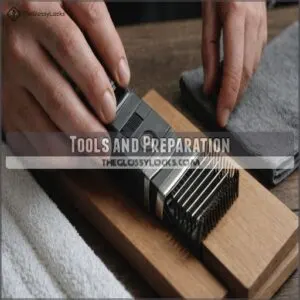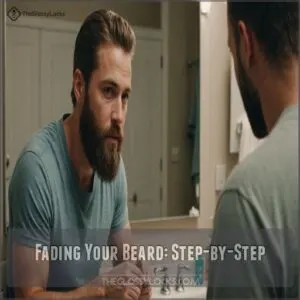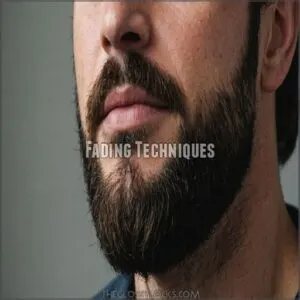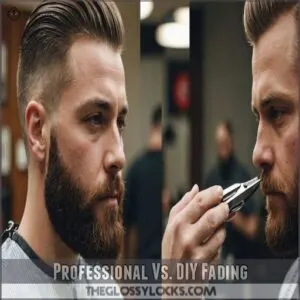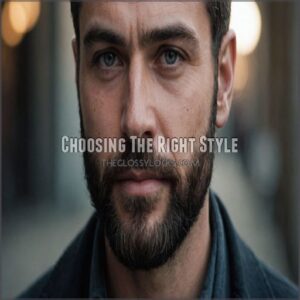This site is supported by our readers. We may earn a commission, at no cost to you, if you purchase through links.
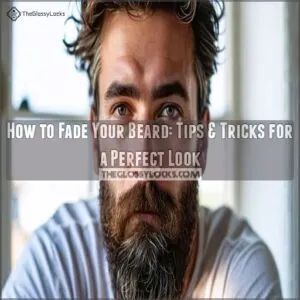 If you’ve ever wondered how to fade your beard like a pro, here’s a simple guide.
If you’ve ever wondered how to fade your beard like a pro, here’s a simple guide.
Start by trimming your beard and mustache to your desired length.
Grab your clippers and begin creating the fade, starting about an inch above the jawline. Gradually increase the length as you move up closer to the top of your sideburns.
This way, you’ll create a smooth blend.
Don’t forget to tidy up stray hairs and add a touch of beard oil for style and shine. With a bit of practice, you’ll achieve that polished look.
Stay tuned for more tips and tricks to perfect it!
Table Of Contents
- Key Takeaways
- What is a Beard Fade?
- Tools and Preparation
- Fading Your Beard: Step-by-Step
- Fading Techniques
- Maintaining Your Fade
- Professional Vs. DIY Fading
- Choosing The Right Style
- Common Mistakes to Avoid
- Tips for a Seamless Fade
- Mastering The Art of Beard Fading
- Frequently Asked Questions (FAQs)
- How do you fade a beard?
- How to prevent facial hair from growing back?
- What is a beard fade?
- Can You fade a patchy beard?
- Should a beard be faded?
- How do you maintain a faded beard?
- How can I fade my beard easily?
- How can I fade my beard color?
- How do I taper down my beard?
- How can I lighten my beard color?
- How often should I wash my faded beard?
- What beard oils work best for a fade?
- Can I fade a patchy beard effectively?
- What if my beard grows unevenly?
- How do I maintain a faded beard in summer?
- Conclusion
Key Takeaways
- Start with a uniform trim and define your neckline and cheek lines before fading to create a clean base for your beard fade.
- Use the right guard sizes and gradually decrease them as you move from longer to shorter areas, creating a smooth transition in your fade.
- Practice regularly and be patient—mastering a beard fade takes time, but consistent trimming every few days will help maintain your style.
- Choose a fade style that complements your face shape and experiment with different techniques to find what works best for you.
What is a Beard Fade?
So, what’s a beard fade? It’s basically a gradual blending of your beard hair from longer to shorter, kind of like a haircut fade, but on your face!
Definition of a Beard Fade
A well-groomed beard starts with a neatly trimmed neckline, like a defined neckline achieved by following natural jawline curves, trimming your neckline short. A beard fade gradually blends your facial hair from long to short, creating a sleek look.
It’s like shading in a drawing for your face.
Here’s how it works:
- Starts high on the cheeks
- Blends into sideburns
- Softens into the chin
- Tapers toward the neckline
- Evens out any harsh lines
For more tips and a detailed beard fade guide to master this style.
This style makes beard trimming an art.
Benefits of a Beard Fade
Feeling overwhelmed by beard care? A beard fade is your secret weapon for a clean, sharp look.
It adds dimension, flattering your face shape while subtly hiding imperfections.
This technique doesn’t just enhance style; it showcases your mastery in barber techniques.
With a few flicks of the trimmer, fading a beard becomes an art form you can easily master.
Types of Beard Fades
Recognizing the benefits, let’s explore the multiple types of beard fades.
High fades deliver a bold look, while low fades offer subtler shading.
Taper fades seamlessly blend into skin, perfect for a clean style.
Side fades highlight those cheekbones, and French fades add flair.
Each beard style calls for special beard trimming, grooming, and consistent beard fade maintenance.
Choose what fits your vibe!
Tools and Preparation
Before you transform your beard into a masterpiece, make sure you’ve got the right tools, like a trusty trimmer and comb.
Also, spend a moment to trim everything evenly and shape those neck and cheek lines for a clean start.
Essential Tools for Fading
Tools of the trade make your beard fade excellent.
Grab the essentials to tame your whiskers:
- Best Trimmer: Adjust lengths like a pro.
- Fade Comb: Make sure the changes are smooth.
- Blade Sharpness: Keep it cutting clean.
- Outliner Use: Define those crisp lines.
Make the task as easy as pie with the right gear!
Trimming to a Uniform Length
A quality beard trimmer and the right comb selection are your best friends when trimming to a uniform length.
It’s tempting to rush, but steady hands make even trimming easier.
Consider maintaining your beard length by trimming every couple of days to keep your style fresh.
Remember, precision is key—like threading a needle, only less stressful!
Defining Neck and Cheek Lines
Now that your beard’s evenly trimmed, let’s shape it!
Find your natural neckline; it’s where your jawline meets your neck.
Use a mirror; imagine a clean line from ear to ear.
For your cheek line, follow your natural cheekbone’s curve.
A sharp, defined neckline and cheek line give your beard style a polished, natural look.
Remember, practice makes perfect!
Experiment to find what beard shape suits you best.
Fading Your Beard: Step-by-Step
Get ready to transform your beard into a masterpiece with a simple, step-by-step approach that even a beginner can follow.
You’ll master fading your neckline, sideburns, and cheeks, making your beard the envy of the block.
Fading The Neckline
Fading the neckline can transform your look from scruffy to sleek.
With a beard trimmer, create a neat neckline shape using blending techniques for sharp lines.
Remember:
- Keep tools handy – your fade tools are your best friends.
- Blend for the win – smooth changes make all the difference.
- Home vs. barber – tackle it at home, or trust a pro.
Fading The Sideburns
After perfecting the neckline, it’s time to tackle those sideburns.
Use your hair clipper with precision to achieve the perfect sideburn fade length and shape.
Focus on using a flicking motion near the ear for smooth, tapered sides.
| Tool | Purpose |
|---|---|
| Hair Clipper | For shaping and tapering sideburns |
| Trimmer | Precision detailing and defining the fade |
| Length Guards | Maintain consistent length and smooth progress |
Fading The Cheeks
Mastering the cheek fade in beard styling is like painting a masterpiece on a canvas—you want smooth changes.
To achieve a seamless look, invest in high-quality fade clippers, available at stores like those offering fade clippers.
Use a shorter guard for cheeks, blend toward the jawline, and avoid sharp lines.
- Key tips:
- Experiment with different cheek fade styles.
- Know your face shapes for best results.
- Use a barber pen for precision.
- Avoid common cheek fade mistakes.
Fading Techniques
When you’re fading your beard, using the right techniques can make all the difference in achieving a smooth look.
Learn how cutting with the grain, selecting the correct guard size, and creating a seamless blend can turn your beard from bushy to beautifully blended.
Cutting With The Grain
Cutting with the grain helps create a smoother beard fade, avoiding razor burn and respecting your hair’s texture.
Imagine this: your beard follows nature’s grain patterns, much like a river flowing naturally.
Here’s a quick guide:
| Key Aspect | Avoid |
|---|---|
| Beard growth direction | Against the grain |
| Hair texture | Harsh angles |
| Shave gel | Dry shaving |
Master your trimming techniques to finesse those natural lines in men’s grooming.
Using The Right Guard Size
Choosing the right guard size is key to achieving your fade length goals.
Start with a higher number guard for longer hair, gradually decreasing the number for shorter lengths.
Smooth changes in guard size are important; don’t jump too many numbers at once.
This fine-tuning technique helps create a natural-looking beard fade.
Remember, practice makes perfect!
A beard brush and beard oil can help maintain your awesome beard fade.
Creating a Smooth Transition
Achieving a smooth change in your beard fade is all about blending and gradual change.
Start using clippers with a proper clipper guard.
To maintain a clean, dry beard, consider these expert tips for a seamless fade on how to fade beard sideburns.
Use feathering motions from the sideburns down for a seamless look.
A touch of beard wax can help keep everything in place.
Think of it like an artist feathering paint for that perfect undercut effect.
Maintaining Your Fade
Keeping your beard fade looking sharp means trimming every two days, which helps your style stay fresh.
Regular practice with your trimmer makes the process easier and helps you master the perfect fade.
Trimming Every Two Days
As you perfect your beard fade techniques, remember the importance of a consistent trimming routine.
Trimming every two days helps maintain fade longevity and guarantees your beard fade remains sharp.
It’s like watering a plant to keep it vibrant.
With regular attention, you can manage the growth rate effortlessly, making your beard style look like a professional barber touched it up.
Regular Trimming for Easy Fading
Wondering why your beard fade loses its fresh look quickly?
Regular trimming keeps things sharp.
Use quality trimming tools every few days to follow your natural beard growth pattern.
This maintenance routine minimizes fade frequency and helps manage costs.
Remember, keeping up with this task makes it easier to achieve the perfect textured side part or shape for round or heart face types.
Practice for Perfecting The Fade
You’ve been keeping your trim game strong, now let’s work on perfecting your fade.
Practice makes perfect, especially when you’re at home experimenting with mutton chops or blending your chin’s appearance.
To help you achieve a seamless blend, remember to use the right trimmer guard.
Mistakes happen, so patience is key.
Choosing between home or barber? It’s your call.
Grab your tools, embrace those bald head vibes, and master those fade techniques!
Professional Vs. DIY Fading
Deciding between a professional beard fade and doing it yourself depends on your goal and budget.
While a pro guarantees precision with each trim, nailing the DIY fade can turn into a badge of honor—just like finally assembling that flat-pack furniture without extra screws left over!
Benefits of Professional Fading
Precision is key, and that’s where professional fading shines. Getting sharper lines and a personalized style from an expert is a game-changer. You’ll achieve consistent results, saving you time and frustration.
Think of it as an investment in your look—a barber’s expert advice guarantees a flawless fade, unlike the sometimes uneven results of DIY attempts.
It’s a time-saving shortcut to a consistently great look. Plus, let’s be honest, sometimes it’s nice to sit back and let someone else handle the details. You get that polished, professional look effortlessly. The peace of mind alone is worth it!
Tips for DIY Fading at Home
Tackling a beard fade at home can feel like jumping into deep waters, but with the right home fade tools, it’s manageable.
Start by investing in a reliable trimmer that fits your fade tools budget.
Practice is key—don’t rush or you’ll risk common fade mistakes, like uneven lines.
Patience will let you master the flicking motion needed for a natural blend.
Regular fade maintenance is essential; aim to trim every few days.
So, grab your tools, watch a few tutorials, and gradually you’ll gain confidence in your DIY beard fading craft.
Choosing The Right Style
Choosing the right beard style can seem tricky, but it’s as simple as matching your beard to your face shape.
You’ll quickly see that a faded beard can enhance your natural features and add a stylish edge.
Face Shapes That Suit a Faded Beard
Choosing the perfect fade hinges on your face shape.
If you’re thinking of trying this at home or with a pro, consider these styles.
For round faces, a high fade can elongate your look.
Oval faces typically handle any fade, while square faces benefit from a softer, lower fade.
Consider accentuating your fade with a stubble beard style to add texture and depth.
Long faces shine with a mid-fade, balancing proportions, and heart-shaped faces can rock a tapered beard to emphasize the chin nicely.
- Round face: High fade
- Oval face: Any fade works
- Square face: Soft lower fade
- Long face: Mid-fade
Common Mistakes to Avoid
When fading your beard, it’s easy to make simple mistakes that can lead to uneven results or a patchy look.
Fading your beard can be tricky, but with a few simple tips, you can avoid common pitfalls.
Avoid common pitfalls like using the wrong guard size or forgetting to trim regularly, and you’ll keep your beard looking sharp.
Uneven Fading
Don’t let uneven fading drive you up the wall.
Start by keeping your hand steady and mirror-check those lines often.
A sneaky spot can make the whole beard look patchy.
Using a precise beard trimmer tool will help you gain more control.
Troubleshooting uneven fades means blending well and adjusting angles steadily.
Achieving perfect fade lines isn’t magic—just patience and practice.
Remember, you’re only a flick away from mastering it!
Incorrect Guard Size
Using the wrong guard size can turn your stylish beard fade into an unscheduled buzz cut.
It’s like wearing the wrong shoe size—uncomfortable and noticeable.
The impact of guard size affects your fade change.
Always refer to a guard size chart and start big.
Beginner mistakes happen, but choosing guards wisely guarantees a smoother, well-blended beard.
Not Trimming Regularly
Maintaining that sharp beard fade requires regular upkeep. Neglecting trims leads to an unkempt look, and that’s no fun! Here’s why consistent fade maintenance matters:
- Your beard grows unevenly.
- Fade upkeep becomes a much bigger chore.
- To avoid irritation from overgrown hairs, you should trim with the grain for softer bulky areas, as seen in proper beard trimming techniques.
- You risk irritation from overgrown hairs.
- It’ll look less defined, less you.
Regular trimming, even just every few days, keeps your beard looking its best, minimizing those irritation risks. It’s all about that fade maintenance!
Tips for a Seamless Fade
Achieving a seamless beard fade involves using barber scissors and a beard trimmer with guard settings(trimming techniques for blending) to work with the natural flow of your hair, avoiding harsh, straight lines. Requires patience and practice, so don’t rush and enjoy the process.
Experiment with different styles and find the right tools to help you nail that perfect look.
Patience and Practice
Fading your beard isn’t a sprint; it’s a marathon.
Avoiding common mistakes starts with patience and practice.
Master the technique, and remember: practice makes perfect.
Here’s a quick guide:
| Step | Common Mistake |
|---|---|
| Consistent Trimming | Uneven Lines |
| Right Tools | Wrong Guard Size |
| Take Your Time | Rushing the Process |
Finding your style takes time, but tools are key.
Experimenting With Different Styles
Ever think about trying a new fade style for your beard?
A little adventure in beard styling can highlight your unique facial features and inspire your overall look.
A beard fade works well with round and heart-shaped faces, but oval and square faces can also pull off this style with some tweaks, according to Mastering the Beard Fade Techniques.
Mixing trendy fades with different beard shapes suits your personality but also gives you a fresh take on the classic beard.
Explore and rediscover what works best for your face!
Finding The Right Tools for The Job
To nail that seamless beard fade, you’ll want the right tools—think of them as your trusty sidekicks.
Invest in the best clippers for fades and explore various beard trimmer types.
Compare an outliner vs. trimmer for crisp lines.
Don’t overlook a reliable comb vs. brush and essential accessories to keep things tidy.
Your confidence will thank you!
Mastering The Art of Beard Fading
Mastering beard fading takes practice, patience, and the right techniques, but it’s not as tricky as it sounds.
With a few advanced tips, you’ll tackle common issues and keep your style fresh and trendy.
Advanced Techniques for Fading
A flawless beard fade can elevate your look instantly, mastering advanced techniques guarantees precision.
Nail it by focusing on these elements:
- Natural Blending for seamless shifts.
- Angled Fades to highlight jawline contours.
- Layering Techniques for added depth.
- Sectional Fading to maintain balance across different beard areas.
- Textured Edges for a dynamic finish.
Stay focused, and remember, practice makes perfect!
Troubleshooting Common Issues
Why’s your beard fade causing you grief? Overgrown patches or skin irritation can be a real pain.
Tackle razor burns and uneven growth like a pro by learning common beard fading issues. Don’t let ingrown hairs ruin your masterpiece—stay sharp!
| Problem | Cause | Solution |
|---|---|---|
| Overgrown patches | Uneven trimming | Regular maintenance |
| Ingrown hairs | Wrong shaving angle | Use softening products |
| Razor burn | Too much pressure | Apply soothing lotion |
| Uneven growth | Skipped areas | Trim with care |
| Skin irritation | Dirty tools or products | Clean and sanitize |
Staying Up-to-Date With The Latest Trends
Addressing common beard fading issues? Now, let’s embrace the constantly changing Beard Style Evolution.
Stay updated with Fading Trends 2024 by following these steps:
- Get inspired by Celebrity Beard Inspiration; their styles are game-changers.
- Explore Beard Fade Apps for personalized adjustment ideas.
- Consider Seasonal Beard Adjustments to keep your look fresh year-round.
Stay sharp, stay stylish!
Frequently Asked Questions (FAQs)
How do you fade a beard?
Every rose has its thorn, but fading your beard shouldn’t be one of them.
Start with a high guard, trim evenly, define lines crisply, and blend downward.
Practice patience and precision, making your beard shine daily.
How to prevent facial hair from growing back?
Stopping facial hair growth completely might require treatments like laser hair removal or prescription creams that slow regrowth.
Home remedies, while helpful, are less effective.
Always weigh options carefully, considering potential outcomes and professional advice.
What is a beard fade?
A beard fade involves gradually blending beard hair length, creating a smooth change that enhances the look, and is achieved through techniques described in how to blend beard into hair. A beard fade smoothly blends different lengths of facial hair, creating a natural shift from longer to shorter areas.
It’s like a haircut for your beard, enhancing your look by softening sharp lines and adding stylish flair.
Can You fade a patchy beard?
Think of a patchy beard as a work in progress.
You can still fade it!
Blend the longer hairs into the patchy areas using a beard trimmer.
This will create a more harmonious and intentional look.
Should a beard be faded?
Fading your beard adds a stylish touch, providing a polished look that can slim your face and complement different styles.
It’s like giving your beard a little flair while maintaining a clean appearance.
Give it a try!
How do you maintain a faded beard?
Did you know 80% of men neglect beard maintenance?
Don’t be that guy. Trim your faded beard every two days, keeping it fresh.
Use a trimmer with adjustable guards, working from high to low numbers.
Regular upkeep’s your ticket to a sharp look.
How can I fade my beard easily?
To easily fade your beard, start with a longer guard and work your way down.
Use a scooping motion for the neckline and flick upwards on the cheeks.
Practice makes perfect, so don’t worry if it’s not flawless at first.
How can I fade my beard color?
You’re looking to blend your beard color?
Start with a subtle dye close to your natural shade.
Apply it gradually from the roots outward, leaving the tips lighter.
This creates a natural-looking fade that’s easy to maintain.
How do I taper down my beard?
From rugged to refined, tapering your beard is a breeze.
Start with the longest guard on your trimmer, gradually decrease the length as you move down.
Use gentle, upward flicking motions to blend, creating a smooth shift from full to faded.
How can I lighten my beard color?
Lightening your beard color isn’t a breeze, but you’ve got options.
Try natural methods like lemon juice or chamomile tea rinses.
For more drastic changes, consider beard-specific dyes or bleaching kits. Always do a patch test first!
How often should I wash my faded beard?
Contrary to popular belief, washing your faded beard daily isn’t necessary.
Aim for 2-3 times a week with beard shampoo. This keeps your beard clean without stripping natural oils.
Between washes, use a damp cloth to freshen up.
What beard oils work best for a fade?
Light, non-greasy oils work best for faded beards.
They’ll moisturize without weighing down your beard or clogging pores.
Try jojoba, argan, or grapeseed oil to keep your fade looking sharp. A little goes a long way!
Can I fade a patchy beard effectively?
Miraculously, you can transform even the patchiest beard!
Focus on blending shorter areas with longer ones.
Use a trimmer with adjustable guards, start with a longer setting, and gradually decrease. Shape strategically to create the illusion of fullness.
What if my beard grows unevenly?
Uneven beard growth? No worries!
You can still rock a fade.
Focus on working with your natural growth pattern.
Use different guard lengths to blend patchy areas smoothly.
Regular trimming and patience will help even things out over time.
How do I maintain a faded beard in summer?
Did you know that 75% of men report their beards grow faster in summer?
To maintain your faded beard, trim every 2-3 days, use a lightweight beard oil, and keep it clean with regular washing.
Stay cool and stylish!
Conclusion
Mastering how to fade your beard isn’t rocket science, but it’s an art that’ll turn heads!
With these tips and tricks, you’re well on your way to achieving that perfect blend.
Remember, practice makes perfect, so don’t get discouraged if your first attempt isn’t flawless.
Experiment with different styles, find the right tools, and soon you’ll be fading your beard like a pro.
Whether you’re going for a subtle taper or a dramatic fade, your beard game is about to level up.
Happy fading!


